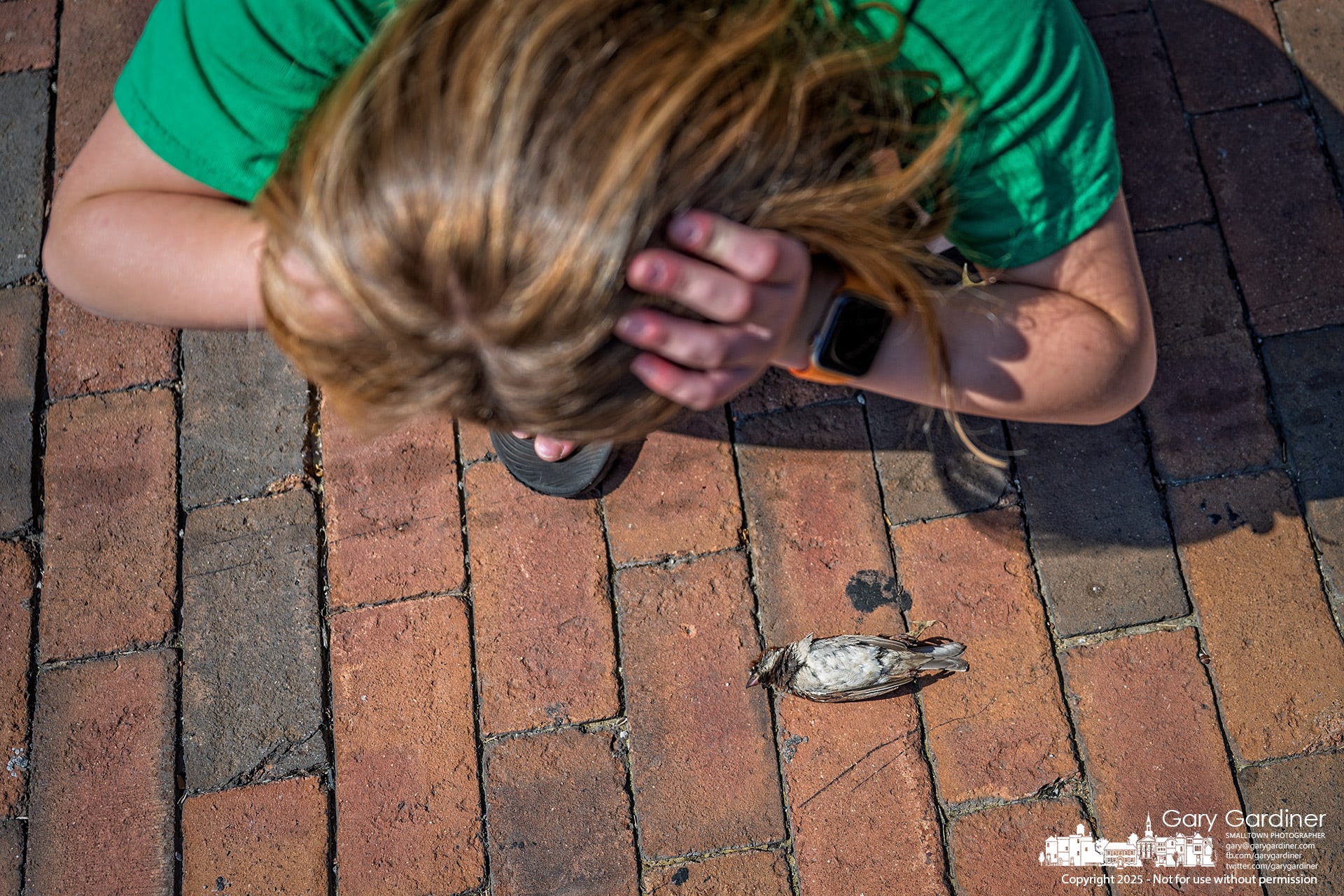In The Quiet Moment
In the quiet hours of an ordinary day, a child kneels on a brick path, their head bent low, hands pressed to their temples in disbelief or grief. Below them lies a small, lifeless bird—unremarkable at first glance, yet now the center of a powerful emotional moment.
It’s a simple photograph. No filters, no fanfare—yet it speaks volumes about childhood, mortality, and our deeply human instinct to bear witness.
The drama in this photograph does not announce itself. There are no sirens, no chaos, no visible tears. Instead, it offers a quiet, grounded tragedy: a bird that likely fell mid-flight, its life interrupted, now lying on sun-warmed bricks. A child, perhaps on their way to school or out playing, has stopped cold. They lean in, not in curiosity but in sorrow. Their hands clutch their head in a posture recognizable to anyone who has ever received unexpected bad news. And it is this gesture, the universality of it, that makes the image so affecting. The photo captures what many of us experienced as children. The first time we realized that things die.
Interestingly, the child’s face is not visible. They are turned away from the camera, offering no eye contact and no direct emotional cues. And yet, their body says it all. This is a powerful reminder that a photograph doesn’t need facial expression to convey emotion. The language of the body, the curve of the spine, the tension in the arms, the stillness of the scene, says far more than a dramatic expression ever could. The anonymity of the child deepens the impact. Without identity, they become a stand-in for all of us, for the universal experience of encountering death for the first time and not knowing quite what to do with it.
Technically, the image is straightforward. It is shot from above, with the sun casting sharp shadows across the ground. The bricks are textured and warm, the child’s shirt a striking green against the muted tones of the walkway. The bird is almost camouflaged, its small form easy to miss, until the child’s attention makes it impossible to ignore. There is no attempt to beautify or dramatize the scene through light or editing. The natural, midday sun provides what photography theorists call “hard light.” Unforgiving, but truthful. Every crack in the brick, every feather on the bird’s body is visible. This type of light can be difficult to work with, but in this case, it enhances the emotional honesty of the photograph.
What makes this photograph linger is not just what it shows, but when it shows it. The image was taken at what French photographer Henri Cartier-Bresson famously called the “decisive moment,” the exact instant when visual form and emotional meaning come into perfect alignment. Had the shutter clicked a few seconds earlier or later, the tension would have been lost. The child might have been walking away. The bird might have gone unnoticed. However, here we are presented with the collision of innocence and finality, frozen in time forever.
The photographer made a split-second decision to capture that tension. And in doing so, they gave us something rare: an unplanned, unpolished glimpse of absolute emotional truth.
There is also a quiet ethics to this photograph. In an era where images are often curated, filtered, or staged, this one observes. It doesn’t intrude. It doesn’t manipulate. It allows the moment to be what it is. This kind of restraint is rare, especially when the subject is emotionally charged. But it’s precisely that restraint that makes the image so powerful. The photographer is not a director here, but a witness—a presence that honors the scene without altering it. As photography critic Susan Sontag once wrote, “To photograph is to appropriate the thing photographed.” But in this case, the photograph feels less like appropriation and more like reverence.
So what does this image ultimately teach us?
It teaches us that drama doesn’t always require spectacle. That death, when viewed through the eyes of a child, becomes a deeply human story. That emotion can live in posture, not just in faces. That light, however harsh, can be honest. That sometimes the most meaningful photographs are not those that shout—but those that listen.
More than anything, it teaches us to look again. Because often, it’s the quiet moments we overlook that carry the most weight.
PhotoCamp Daily is not a newsletter about the technical skills required to be a good photographer or become a photojournalist. There is a multitude of videos, self-help books, training courses, and classes, and then there is the power of social media as an instructional tool.
PhotCamp Daily is about learning to experience making good photos. About learning to better observe subjects and their relationship to story. Learning yourself to express better what will become a collective view of your world and the new experiences you will encounter.
PhotoCamp Daily is always free! But you can pledge support at any time.
Consider subscribing to The Westerville News and My Final Photo News. Also recommended is Into the Morning by Krista Steele.
My Final Photo News is a reader-supported publication. To receive new posts and support photography and commentary, consider becoming a free or paid subscriber.


